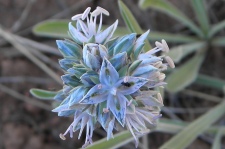 Sundews are dimunitive, but deadly (at least if you are a small insect). Here is English sundew (Drosera anglica) as seen at Willow Lake. This species is considered rare in California and is easy to miss, standing just an inch or two high. It is a close relative of the roundleaf sundew (Drosera rotundifolia, see below), which is also present at Willow Lake and has leaves that are round instead of elongate. There are over 150 species of Drosera worldwide, but these are the only two native sundew known to California.
Sundews are dimunitive, but deadly (at least if you are a small insect). Here is English sundew (Drosera anglica) as seen at Willow Lake. This species is considered rare in California and is easy to miss, standing just an inch or two high. It is a close relative of the roundleaf sundew (Drosera rotundifolia, see below), which is also present at Willow Lake and has leaves that are round instead of elongate. There are over 150 species of Drosera worldwide, but these are the only two native sundew known to California.
Carnivory is a great strategy for survival out on the floating bog mat of Willow Lake. The acidic environment created by undecomposed organic matter renders nutrients such as nitrogen less available than they would be in mineral soil. The sundews thus fortify their diets with insects, a great source of protein. Insects are attracted to the sweet, sticky secretions at the tips of these reddish hairs, and find that once they land they cannot leave. Eventually, enzymes produced by the plant will break down the insect so that their nutrients can be absorbed into plant tissues.
- Species:Drosera anglica (English sundew)
- Plant Family: Droseraceae
- Where I saw it: Willow Lake, Plumas County
- Look also: fens and wet meadows of the northern Sierra Nevada, Southern Cascades, and Klamath ranges




